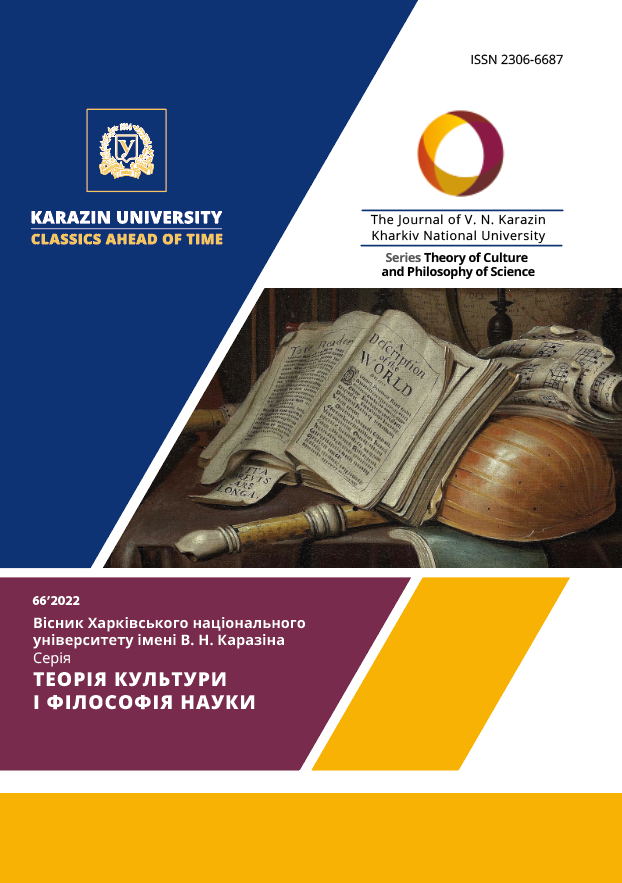VIDEOGAMES AS A SPACE FOR RECONSTRUCTING MYTHOLOGICAL STRUCTURES
Abstract
The article is dedicated to the cultural-philosophical study of the video game space as a place for the reconstruction of archaic mythological structures. The study of narrative video games, which emerged in the early 1980s, represents new media that interactively transmit mythological motifs into the gaming experience. To identify and study mythological elements in video games, the methodological basis includes the works of C.G. Jung and C. Kerényi, who developed concepts of archetypes in culture. Also utilized is the concept of the monomyth by J. Campbell, which involves the realization of the hero's journey cycle initially in legends and myths, and later in narrative artistic structures. The novelty of the study is determined by the low level of research into the replication of mythological elements in the environment of new interactive media. Analyzing the universality of myth in gaming realms is part of a comprehensive approach to studying the phenomenon of video games and is an important element of the non-reductionist concept in the field of Game Studies. The relevance of the work lies in the need to comprehend the video game experience as a practice of personal living through history by the player, rather than passive contemplation.
The study identified trends in constructing plots in narrative games according to the principles of the monomyth. In narrative games of the late 20th century, we find more primitive expressions of monomyth elements, often associated with technological limitations in construct implementation. Instead, video games of the past two decades reflect the monomyth in its entirety, characterized by complications and repetitions of the hero's journey stages.
Equally pronounced are the reconstructions of archetypes and archetypal figures in the video game space. Thus, among the first archetypal figures in the gaming industry are the images of the hero, translated into the player's avatar, the damsel in distress - as a plot-forming element, and the gatekeeper, realized in level bosses. Modern narrative games allow for the differentiation of additional archetypes, such as the mentor, shadow, or ally.
The main feature of reconstructing mythological structures in the gaming space is recognized as interactivity and the ability to experience events in a virtual world, which creates a new type of experience for the player in actively realizing universal mythological motifs through playing myths, rather than simply observing them.
Downloads
References
Hrebeniuk A. V. Death in video games in the context of remythologization processes / Sociological Studies. Lutsk: Lesya Ukrainka Eastern European National University, 2016. № 1 (8). Р. 11-15. (In Ukrainian)
Campbell, J. The Hero with a Thousand Faces, Lviv: Terra Incognita, 2021. 416 с. (In Ukrainian)
Pydiura O., Pydiura, І. Interaction of folklore and video game for example Hellblade. Senuas Sacrifice / Young scientist, 2019. № 12 (76), Р. 146-150. DOI: https://doi.org/10.32839/2304-5809/2019-12-76-34 (In Ukrainian)
Aarseth, E. J. (1997). Cybertext: Perspectives on Ergodic Literature, Baltimore and London: The Johns Hopkins University Press, 1997. 203 p. (In English).
Apperley, T. H. Genre and game studies: Toward a critical approach to video game genres / Simulation & Gaming. 2006. P. 6-23 (In English).
Asimos, V. Playing the Myth. Video Games as Contemporary Mythology, Implicit Religion, 2019. № 21(1), Р. 92-109. DOI: https://doi.org/10.1558/imre.34691 (In English).
Bogost, I. Unit Operations: an Approach to Videogame Criticism, Cambridge: MIT Press, 2008. 260 p. (In English).
Frasca, G. Ludology Meets Narratology: Similitude and Differences between (video)games and Narrative / Ludology, 2011. URL: www.ludology.org/articles/ludology.htm (In English).
Guyker, R.W. Jr. Myth in Translation: The Ludic Imagination in Contemporary Video Games, Santa Barbara: Pacifica Graduate Institute, 2016. 456 p. (In English).
Jung, C.G. The Archetypes and the Collective Unconscious, Princeton: Princeton University Press, 1981. 470 p. (In English).
Jung, C. G., Kerényi, С. Essays on a Science of Mythology: The Myth of the Divine Child and theMysteries of Eleusis, Princeton: Princeton University Press, 1969. 208 p. (In English).
Juul, J. Games Telling Stories: A brief note on games and Narratives / The International Journal of Computer Game Research, 2001. URL:https://www.gamestudies.org/0101/juul-gts/ (In English).
Juul, J. The definitive history of games and stories, ludology and narratology / The Ludologist, 2004. URL: https://www.jesperjuul.net/ludologist/2004/02/22/the-definitive-history-of-gamesandstories-ludology-and-narratology/ (In English).
Kerenyi, K. Athene: Virgin and Mother in Greek Religion, Washington: Spring Publications, 1998. 104 p. (In English).
Kiberd, D. Men and Feminism in Modern Literature, London: Palgrave Macmillan UK, 1985. 250 р. (In English).
Klaus,S. Heroesin Virtual Space. Zagreb: Studia Ethnologica Croatica, 2010. №. 22. P. 361–391
Segal, R. A. Myth: A Very Short Introduction, Oxford: Oxford UP, 2015. 176 р. (In English).
Todor, A. Video games as myth reconstructions, Braşov: Transilvania University of Brașov, 2010. 85 р. (In English).
Vandewalle, A. Video Games as Mythology Museums Mythographical Story Collections in Games / International Journal of the Classical Tradition, 2023. URL: https://link.springer.com/article/10.1007/s12138-023-00646-w (In English).
Wolf, M. J. P. Encyclopedia of Video Games: The Culture, Technology, and Art of Gaming, Santa Barbara: Greenwood, 2012. 740 p. (In English)
Wolf, M. J. P. The Medium of the Video Game, Texas: University of Texas Press, 2001. 223 p. DOI: https://doi.org/10.7560/791480 (In English).




